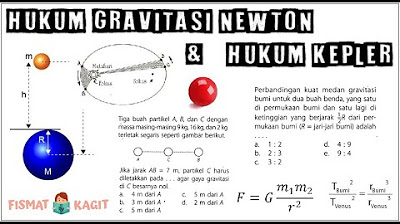Force at a distance! Induced magnets and domain theory!
Summary
TLDRThis video explains the concept of 'force at a distance' in physics, demonstrated through the interaction between a magnet and a paperclip. The script introduces the idea of force fields, focusing on magnetic fields and the concept of induced magnetism. It explains how magnetic domains within materials like iron align to create magnetism. The video also distinguishes between magnetic, electric, and gravitational fields, highlighting key differences such as the nature of their interactions and field lines. A 3D visual demonstration helps emphasize the three-dimensional nature of magnetic fields.
Takeaways
- 😀 Force at a distance is a key concept in physics, where forces act without direct contact, as demonstrated by a magnet and a paperclip.
- 🧲 The interaction between a magnet and a metal object like a paperclip is due to the magnetic force field, even when the objects are not in physical contact.
- 🧠 Magnetism can be explained using the domain theory, where tiny magnetic domains in ferrous materials like iron align when exposed to a magnetic field.
- 🔧 Magnetic domains in an unmagnetized object are randomly oriented, but when exposed to a magnet, they align, creating induced magnetism.
- ⚙️ A magnet induces magnetism in nearby ferrous objects, but once the magnetic field is removed, the object loses its induced magnetism.
- 🌍 Force fields describe how forces act over a distance. Examples include magnetic, electric, and gravitational fields.
- 📏 Magnetic force fields are represented by lines of flux, with the field strength being stronger where the lines are closer together.
- 🔋 Electric fields act on charged particles, magnetic fields act on magnetic poles, and gravitational fields act on masses, each with distinct properties.
- 🔄 In electric fields, opposite charges attract and like charges repel, while in magnetic fields, opposite poles attract and like poles repel.
- 💡 Gravitational fields only attract, as mass cannot be negative, while electric and magnetic fields involve both attraction and repulsion.
- 🌐 Magnetic fields are three-dimensional, and this can be visualized with demonstrations showing the full extent of magnetic field lines in space.
Q & A
What does 'force at a distance' mean in physics?
-In physics, 'force at a distance' refers to the idea that a force can act on an object without direct contact. An example of this is the attraction between a magnet and a paperclip, where the magnet exerts a force on the paperclip without touching it.
How does a paperclip become magnetized when brought near a magnet?
-When a magnet is brought near a paperclip, the metal inside the paperclip contains tiny regions called 'magnetic domains.' These domains, which are usually randomly oriented, align in the same direction due to the influence of the external magnetic field, causing the paperclip to become magnetized.
What is induced magnetism?
-Induced magnetism occurs when a material, like a paperclip, becomes magnetized due to the influence of an external magnetic field. This magnetism is temporary and disappears once the external field is removed.
What are magnetic domains?
-Magnetic domains are small regions within magnetic materials where the magnetic moments of atoms are aligned in the same direction. In unmagnetized materials, these domains are randomly oriented, but they align when exposed to a magnetic field, creating a magnetic effect.
How does the strength of a magnetic field relate to the density of the field lines?
-The strength of a magnetic field is represented by the density of the field lines, known as lines of flux. The closer the lines are to each other, the stronger the magnetic field in that region.
What is the main difference between electric fields and magnetic fields?
-Electric fields act on charged particles, with field lines pointing from positive to negative charges. In contrast, magnetic fields act on magnetic poles, with field lines pointing from north to south. This fundamental difference distinguishes the two types of fields.
Why can't a magnet have only a north or south pole?
-A magnet cannot have only one pole (a monopole) because magnetic fields always exist as dipoles, meaning there is always both a north and a south pole. This is a fundamental property of magnetism.
What is a key difference between gravitational fields and magnetic/electric fields?
-Gravitational fields only exhibit attractive forces, acting on masses, whereas electric and magnetic fields can have both attractive and repulsive forces. Additionally, gravitational fields are unique because there is no negative mass to repel other masses.
What are the key characteristics of a magnetic field?
-A magnetic field has the following key characteristics: it acts on magnetic poles (both permanent and induced), its lines of flux always point from north to south, and it is a 3D field, even though it is often represented in two dimensions.
How do we visualize the three-dimensional nature of a magnetic field?
-We can visualize the three-dimensional nature of a magnetic field through demonstrations such as a magnet in a bottle, which shows the full 3D structure of the magnetic field lines, helping to understand their complexity beyond simple 2D representations.
Outlines

このセクションは有料ユーザー限定です。 アクセスするには、アップグレードをお願いします。
今すぐアップグレードMindmap

このセクションは有料ユーザー限定です。 アクセスするには、アップグレードをお願いします。
今すぐアップグレードKeywords

このセクションは有料ユーザー限定です。 アクセスするには、アップグレードをお願いします。
今すぐアップグレードHighlights

このセクションは有料ユーザー限定です。 アクセスするには、アップグレードをお願いします。
今すぐアップグレードTranscripts

このセクションは有料ユーザー限定です。 アクセスするには、アップグレードをお願いします。
今すぐアップグレード関連動画をさらに表示

FISIKA KELAS XII || GAYA LORENTZ PADA KAWAT SEJAJAR

FISIKA Kelas 12 - Hukum Coulomb & Medan Listrik | GIA Academy

HUKUM NEWTON TENTANG GRAVITASI & HUKUM KEPLER | FISIKA KELAS 10

LORENTZ FORCE Rail + Rolling Conductor + i + Magnetic Field 🧲 + 3 Fingers Right Hand Rule 👆 PCCL

Fisika Kelas XI: Dinamika Benda Tegar

Campo Elétrico - Brasil Escola
5.0 / 5 (0 votes)
